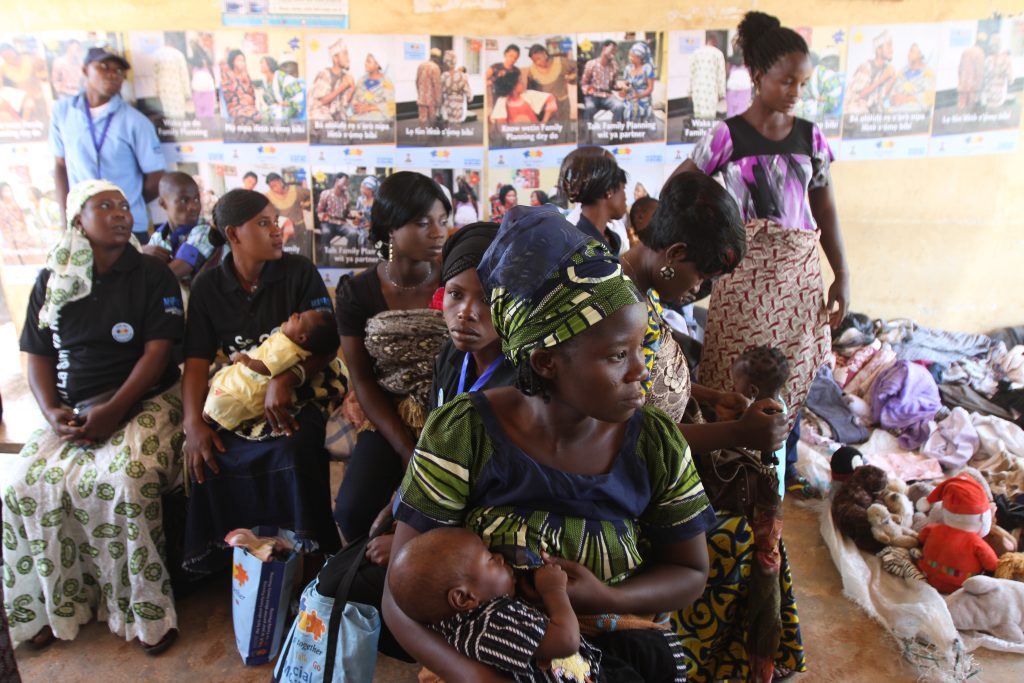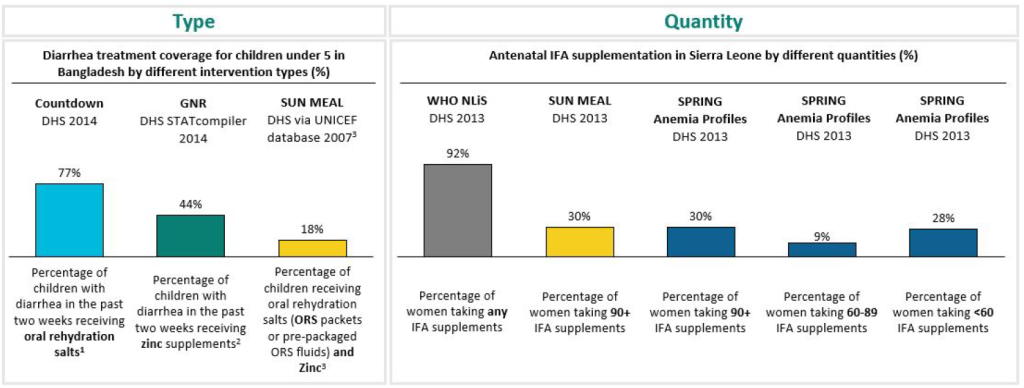
Nursing mothers wait outside the antenatal unit at Orolodo primary health centre before the start of a family planning visibility parade in Omuaran township in Nigeria’s central state of Kwara. © 2012 Akintunde Akinleye/NURHI, Courtesy of Photoshare
High-quality nutrition data is critical for country stakeholders, advocates, funders, and many others to assess needs, measure progress, and ultimately make decisions to take action. However, as our global data visualization tool (DVT) in nutrition landscaping revealed: many DVTs report nutrition indicators that have similar or even the same name but vary in definition and/or years and sources of data presented.
This variability presents challenges for many types of nutrition data users. In an online survey of global nutrition data users conducted by DataDENT, we found that 46% of respondents are frequently or sometimes unsure of which indicator to reference because there are multiple statistics and definitions for the same indicator. Anecdotally, we heard the same from nutrition stakeholders we interviewed. They said that finding the right data for their needs can be a very time-intensive process because there is no central repository that reflects all nutrition indicator frameworks and tools.
This underscores the challenge: DVTs reporting common indicators using different definitions can lead to confusion and potentially make it more challenging to make decisions, set agendas, and advocate for policies. To characterize the extent of the problem, we conducted an in-depth review of seven global DVTs:
1. Scaling Up Nutrition Monitoring, Evaluation, Accountability, and Learning Country Dashboards
2. Global Nutrition Report Nutrition Country Profiles
3. Hunger and Nutrition Commitment Index Country Scorecards
4. Countdown Country Dashboards
5. Global Breastfeeding Scorecard
6. WHO Nutrition Landscape Information System Country Profiles
7. Strengthening Partnerships, Results and Innovations in Nutrition Globally (SPRING) National Anemia Profiles.
We also reviewed the WHO-UNICEF Global Nutrition Monitoring Framework to better understand how indicators compare across these high-profile frameworks.
The challenge: multiple indicators for the same topic
From our analysis, we found key differences in two categories of indicators: (1) intervention coverage and (2) policy classification.
Intervention coverage indicators varied by the type and the quantity of the intervention being measured.
For example, as illustrated below, for the treatment of diarrhea in children under five in Bangladesh, there are a number of indicators reported across different DVTs. Both ORS and zinc are recommended for diarrhea treatment. The Countdown to 2030 country profile reports coverage of ORS supplementation only among children with diarrhea in the last 2 weeks (77% DHS 2014) which is nearly twice the coverage of zinc for diarrhea in the last two weeks reported by GNR (44% DHS 2014). SUN MEAL reports children who received both ORS and zinc for diarrhea in the last two weeks which is by far the lowest (18% DHS 2007). Additionally, the most recent versions of DVTs may use different data source years, therefore reporting different values for the indicator. For example, SUN MEAL’s 2019 country dashboard reports both a different indicator definition and an outdated data source year (i.e., 2007) for diarrhea treatment. Finally, DVTs report varying levels of detail on the actual data source used – for the diarrhea example below, DVTs reference only the database or a set of surveys they pulled the data from, whereas for other indicators DVTs note the exact survey or data source.
Similar issues exist when specifying intervention quantities, such as the number of IFA supplements consumed during pregnancy, which is also highlighted in the image below with data from Sierra Leone.

Policy classification indicator differences were largely reflected among DVTs reporting the existence or implementation of policies and plans.
For example, as illustrated below, SUN MEAL and the Global Breastfeeding Scorecard reported the implementation of maternity protection legislation differently. This resulted in different conclusions for the same countries – in this case, Haiti, Guinea and Mali where SUN suggests more complete compliance than the Global Breastfeeding Scorecard – potentially leaving countries and development partners unclear on the action needed. Other common indicators that seem to have similar issues include Implementation of the Code of Marketing of Breastmilk Substitutes and inclusion of national nutrition targets in national policies.

Looking ahead: how to improve the existing landscape
Lack of globally standardized definitions for several recommended nutrition indicators is likely a major contributing factor for why different DVTs report different definitions for the same indicator. This challenge underscores the need for more visibility and clarity on available existing nutrition data resources (including nutrition DVTs and potentially primary data sources), nutrition indicators currently included in those existing resources, and potentially guidance on when those nutrition indicators may be useful for certain contexts. There could also be a need to strengthen data literacy among data users to improve how DVTs are interpreted and used for decision-making. Such guidance and support could help mitigate the challenges around navigating data resources and improve the use of nutrition data in several ways including individual decision-making and country stakeholders’ abilities to align around country needs and respond to them.
DataDENT is involved in several efforts to support development of globally-standardized indicators and to promote their uptake in national surveys and administrative systems. Watch this blog and visit our resource page to learn more.
We want to hear from you!
• In what situations do you regularly access and use nutrition data visualization tools? What do you use them for?
• What challenges have you experienced in accessing and using nutrition indicators to support decision-making and/or agenda-setting needs?
• What type of support would be useful in addressing your needs?
Please use the comment box below to share your thoughts and contact Renee Manorat (rmanorat@r4d.org) if you would like more information about this work.
To see the full indicator mapping referenced in the blog post and detailed brief on the mapping, please click here.
